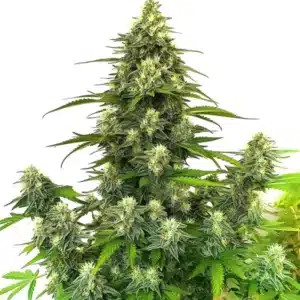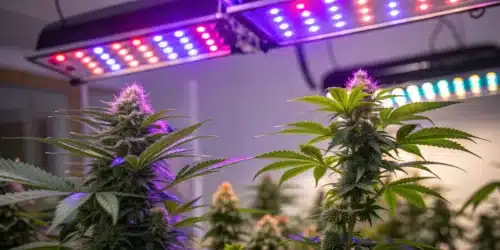Discover the critical distinctions between autoflower and feminized cannabis seeds to elevate your cultivation journey. This comprehensive guide sheds light on each type’s unique advantages, helping you make an informed choice tailored to your growing conditions and goals.
Introduction to Cannabis Seeds: Autoflower and Feminized
The world of cannabis cultivation is as diverse as it is fascinating, with two terms often popping up for novice and experienced growers alike: autoflower and feminized seeds. The nuances of these seed types is crucial for anyone looking to delve into cannabis cultivation, as the choice between autoflower and feminized seeds can significantly influence your growing experience, the appearance of your buds, and the quality of your harvest. Even those concerned about issues like ugly buds can benefit from selecting the right seed type to ensure a more successful cultivation process.
Promos & Deals
What Are Autoflower Cannabis Seeds?
At the heart of the modern cannabis cultivation dialogue, the distinction between autoflower and feminized seeds holds significant importance. Autoflower cannabis seeds represent a breakthrough in cannabis cultivation, offering a unique set of advantages that cater to both novice and experienced growers. This innovation has spurred a broader discussion, often summarized as the autoflower vs feminized debate, which delves into the nuances of each seed type and their implications for the cannabis cultivation landscape.
Autoflower seeds are derived from the Cannabis ruderalis species, which is known for its hardy nature and automatic transition from the vegetative to the flowering stage without the need for a change in light cycles. This is a stark contrast to the traditional photoperiod strains, which require specific light conditions to flower. The term “autoflower” encapsulates this plant’s ability to bloom based on age, rather than the light, offering a streamlined cultivation process.
For growers aiming for a quick turnaround, we recommend checking out our selection of the fastest autoflower strains. These strains not only offer a short cultivation cycle but also maintain high quality standards.
One of the key benefits of autoflower cannabis seeds lies in their simplicity and efficiency. These seeds are well-suited for growers looking for a straightforward cultivation journey, as autoflowers eliminate the need for strict light schedule management. This characteristic makes them ideal for beginners or those with limited space, as autoflower plants can thrive in environments where controlling the light cycle is challenging. Furthermore, the autoflowering trait allows for multiple harvests within a single season, a feature particularly appealing in regions with shorter growing periods.
When discussing autoflower vs feminized seeds, it’s essential to highlight the operational and yield differences between these two seed types. Autoflowers typically have a faster seed-to-harvest time, often ready for collection in as little as 8-10 weeks post-germination. This rapid growth cycle allows growers to produce more crops in a given year, enhancing the potential for continuous production.
Despite their compact size and faster growth cycle, autoflowers can produce impressive yields, especially when grown under optimal conditions. Advances in breeding have led to the development of autoflower strains that rival the potency and yield of their photoperiod counterparts, narrowing the gap within the autoflower vs feminized debate. This evolution has expanded the appeal of autoflower seeds, making them a viable option for those seeking a balance between efficiency and output.
In the broader context of the autoflower vs feminized discussion, it’s clear that autoflower cannabis seeds offer a distinctive approach to cultivation, marked by ease of growth and adaptability. Whether you’re a seasoned cultivator exploring efficient cultivation strategies or a hobbyist seeking to navigate the cannabis cultivation world with ease, autoflower seeds present a compelling option that merits consideration.
What Are Feminized Cannabis Seeds?
In the vast and evolving world of cannabis cultivation, feminized cannabis seeds hold a pivotal role, especially when compared in the context of Autoflower vs Feminized discussions. These seeds are the result of genetic selection and breeding techniques designed to ensure that almost every plant grown from them will develop into a female. This trait is particularly significant in cannabis cultivation because only female plants produce the buds rich in cannabinoids such as THC and CBD, which are sought after for both medicinal and recreational use.
The process of creating feminized seeds involves inducing a female plant to produce pollen, which is then used to pollinate another female. Since the pollen comes from a plant with only female genetics, the seeds produced in this way lack male chromosomes. Consequently, plants grown from feminized seeds are virtually guaranteed to flower as females, thereby eliminating the need for growers to identify and remove male plants during the early flowering stage. This aspect is crucial for maximizing yield and efficiency in the grow space, making feminized seeds an appealing choice for both commercial growers and hobbyists alike.
Integration with Autoflower vs Feminized Discussion
In the ongoing debate of Autoflower vs Feminized seeds, the unique attributes of feminized seeds helps growers make informed decisions based on their cultivation goals, expertise, and resources. Unlike autoflowers, which automatically transition from the vegetative stage to the flowering stage with age, feminized plants’ flowering is triggered by changes in the light cycle. This difference presents a critical consideration for growers, as it implies that feminized seeds might require more attention to light management but also offer greater control over the plant’s growth phases and potentially higher yields due to the plants’ ability to grow larger during an extended vegetative stage.
Moreover, when deciding between autoflower and feminized seeds, one must consider the grow environment (indoor vs. outdoor), desired harvest size, and the grower’s level of experience. Feminized seeds are often preferred for indoor grows where the grower can closely control light cycles and environmental conditions, aiming for optimum yields and quality. On the other hand, autoflower seeds might be favored for their simplicity, resilience, and fast turnaround, especially in outdoor environments or under less controlled conditions.
Key Differences Between Autoflower Vs Feminized Seeds
The growth cycle of cannabis plants is fundamental when comparing autoflower vs feminized seeds, as it directly impacts everything from your growing strategy to the timing of your harvest. Let’s dive deeper into how these seed types differ in their growth cycles and what it means for growers.

Light Dependency: The Crucial Difference
One of the most significant distinctions in the growth cycle of autoflower vs feminized seeds lies in their light dependency. Autoflower cannabis seeds are genetically designed to flower after a certain period regardless of the light cycle. This independence from light changes makes autoflowers exceptionally appealing to those who value simplicity and efficiency in their cultivation process. Without the need to adjust light schedules, growers can maintain a consistent light cycle throughout the plant’s life, simplifying the growing operation.
In contrast, feminized seeds depend heavily on specific light schedules to transition from the vegetative stage to the flowering phase. Typically, this means altering the light exposure from 18 hours of light to 12 hours of light per day, which mimics the natural transition from summer to autumn. This requirement for light manipulation allows growers a greater degree of control over the flowering time but adds an extra layer of complexity to the cultivation process.
Time to Harvest: Speed vs Yield
When considering autoflower vs feminized seeds, it’s essential to factor in the time to harvest. Autoflower seeds are celebrated for their quick turnaround, with some strains ready for harvest in as little as 8-10 weeks from germination. This rapid growth cycle is a game-changer for those looking to produce cannabis efficiently, offering the possibility of multiple harvests within a single growing season.
On the other hand, feminized seeds typically have a longer vegetative stage, which, while extending the time to harvest, can result in larger plants and potentially higher yields. This longer growth period allows feminized plants to develop a robust root system and foliage, which can contribute to a more substantial harvest of flowers. For cultivators focused on maximizing yield over a longer timeframe, feminized seeds may be the more suitable choice.
Autoflower vs Feminized: Navigating the Growth Cycle
Choosing between autoflower and feminized seeds ultimately depends on the grower’s priorities, whether that be the speed and simplicity of autoflowers or the higher yield potential and control offered by feminized seeds. Autoflowers can be particularly beneficial in regions with shorter growing seasons, as their quick turnaround allows for cultivation outside of the traditional growing calendar. Meanwhile, feminized seeds might appeal more to those with controlled indoor environments where light cycles can be precisely managed to optimize plant development.
In the cultivation process of autoflower and feminized cannabis seeds, each type offers a distinct set of traits suited to various growing styles and objectives. Knowing the specifics of their growth patterns helps cultivators choose the option that matches their goals, whether they prefer the fast harvests of autoflowers or the larger yields that feminized seeds deliver.
The Benefits of Growing Autoflower Cannabis
In the ongoing debate of autoflower vs feminized cannabis seeds, each type brings unique advantages to the table. However, when it comes to autoflower cannabis, the benefits are especially appealing to certain growers for a variety of reasons. Below, we delve deeper into these advantages, showcasing why autoflowers have become a popular choice in the cannabis cultivation community.
Efficiency and Speed: One of the most significant benefits of growing autoflower cannabis is the remarkable speed of its growth cycle. Autoflower plants can transition from seed to harvest in a mere 8-10 weeks. This rapid lifecycle is a game-changer for growers looking to maximize their output within a limited timeframe. For those balancing the choice of autoflower vs feminized seeds, the quick turnaround of autoflowers often tips the scale in their favor, especially when multiple harvests per season are a priority.
Simplicity in Cultivation: Autoflower plants are renowned for their hardiness and resilience, which makes them an ideal candidate for both novice growers and those seeking a low-maintenance cultivation process. Unlike their feminized counterparts, autoflowers do not require a change in light cycles to initiate the flowering stage. This autoflowering trait simplifies the growing process considerably, as cultivators do not need to worry about light leakage or precise light schedules, making them a straightforward choice for beginners or for those preferring a hands-off approach in the autoflower vs feminized debate.
Versatility and Adaptability: Autoflower cannabis plants possess a robust genetic makeup that allows them to adapt to various growing conditions with ease. This adaptability makes them suitable for both indoor and outdoor cultivation, providing growers with flexibility in their growing operations. Whether faced with fluctuating temperatures or inconsistent light patterns, autoflowers show a remarkable ability to thrive, which can be a significant advantage for those in regions with less than ideal growing conditions. Their resilient nature contributes to the ongoing discussion of autoflower vs feminized seeds, often being the deciding factor for those in challenging climates.
Space-Efficient: Due to their compact size, autoflowers are incredibly space-efficient, making them perfect for growers with limited space. Whether you’re working with a small indoor setup or a modest outdoor garden, autoflowers can fit snugly into your available area without compromising on the quality of your harvest. This space efficiency is particularly appealing in the autoflower vs feminized comparison, as it allows for the cultivation of multiple plants in tight quarters, maximizing the use of every available inch.
Consistent Quality: Despite misconceptions, autoflower cannabis plants can produce high-quality buds that rival those of their feminized counterparts. Advances in breeding techniques have significantly improved the potency and flavor profiles of autoflower strains, making them a viable option for connoisseurs and medical users alike. When considering autoflower vs feminized seeds, it’s essential to recognize that quality is no longer a differentiating factor, as both can yield premium-quality cannabis under the right conditions.

The Advantages of Feminized Cannabis Seeds
When delving into the world of cannabis cultivation, the debate of Autoflower vs Feminized seeds becomes highly relevant, as each type brings its unique set of benefits and challenges. Specifically focusing on feminized cannabis seeds, it’s crucial to understand their significant advantages and how they stand out, particularly in a comparison with their autoflower counterparts.
Higher Yield Potentials
One of the most compelling reasons to choose feminized cannabis seeds is their potential for higher yields. Unlike autoflower plants, which have a predetermined size due to their genetic makeup, feminized plants’ growth and yield can be significantly enhanced through various cultivation techniques. This includes optimizing the light cycle, which is a critical factor that feminized plants can uniquely benefit from. Given their dependency on the light cycle to transition from the vegetative stage to the flowering stage, growers have the opportunity to extend the vegetative period, thereby allowing the plants to grow larger and, ultimately, produce more buds.
Control Over Plant Sex
The creation of feminized seeds has revolutionized cannabis cultivation by virtually eliminating the risk of growing male plants. Male cannabis plants do not produce the bud that is desired for recreational and medicinal purposes; they can also pollinate female plants, leading to seeded flowers rather than the preferred seedless (sinsemilla) buds. Feminized seeds ensure that nearly every plant grown will be female, a critical factor in maximizing the efficiency and yield of your cultivation space. This advantage is particularly noteworthy in the Autoflower vs Feminized debate, as it simplifies the growing process and ensures that resources are not wasted on plants that will not contribute to the final harvest.
Suitable for Controlled Environments
Feminized seeds excel in controlled environments, where the grower can adjust conditions to meet the specific needs of the plants. This is in contrast to autoflower seeds, which are often praised for their robustness and ability to thrive in various conditions with minimal intervention. However, for those who are willing to invest the time and resources into their cultivation environment, feminized seeds offer the chance to fine-tune conditions such as light, temperature, and humidity to optimize growth and maximize yields. This level of control appeals to serious cultivators who are keen on pushing the limits of what their cannabis plants can achieve.
Strategic Planning and Crop Consistency
Growing feminized seeds allows for more strategic planning in your cultivation efforts. Since the plants’ flowering is triggered by changes in the light cycle, growers can plan the exact timing of their harvests. This predictability is invaluable for ensuring a consistent supply, whether for personal use or commercial purposes. Moreover, the uniformity of feminized plants in terms of growth patterns and flowering times facilitates a more streamlined cultivation process, leading to a more consistent product in terms of size, potency, and yield.
How to Choose Between Autoflower and Feminized Seeds
Considerations for Your Growing Environment
Your cultivation environment plays a pivotal role in determining the best seed type. Autoflowers offer flexibility, while feminized seeds might be better suited to controlled indoor setups.
Your Cultivation Goals
Whether you prioritize quick harvests, large yields, or ease of cultivation can guide your decision between autoflower and feminized seeds.
Budget Considerations
Consider your budget for both time and financial resources when choosing between autoflower and feminized seeds, as each has different requirements for optimal growth.
Autoflower vs Feminized
Choosing the right cannabis seed type depends on your specific growing conditions, experience level, and cultivation goals. Whether you prefer the quick and simple nature of autoflower seeds or the high-yield potential of feminized seeds, knowing their differences is essential for a successful cultivation journey.
Frequently Asked Questions
Are autoflower seeds less potent than feminized?
The potency of a cannabis plant depends on its genetics and growing conditions rather than whether it is autoflower or feminized. Both types can produce high-quality, potent cannabis if grown under optimal conditions. However, some cultivators believe that because autoflowering plants have a shorter growth cycle, they might not always achieve the same level of potency as their feminized counterparts, which have more time to develop their cannabinoid profiles.
Can autoflower and feminized plants be grown together?
Yes, autoflower and feminized plants can be grown together, but it requires careful planning due to their differing light requirements. Autoflowers can tolerate more light and don’t require a change in the light cycle to start flowering. In contrast, feminized plants need a shift to a 12/12 light cycle (12 hours of light and 12 hours of darkness) to flower. A grower can accommodate both by using separate grow areas or by timing the grow cycle to align the flowering stage of both plant types.
How to ensure a successful harvest with either seed type?
Success with either autoflower or feminized seeds hinges on recognizing their unique needs. Autoflowers prefer a consistent light schedule and minimal stress, while feminized plants may require more attention to light cycles and pruning. Providing the right nutrients, adequate lighting, and the appropriate growing medium, along with regular monitoring for pests and diseases, will ensure a successful harvest regardless of the seed type.
Do autoflower plants yield less than feminized plants?
Generally, autoflower plants have a smaller stature and, therefore, may yield less per plant compared to feminized plants. However, autoflowers can be grown more frequently due to their shorter cycle, potentially leading to a comparable cumulative yield over time. For cultivators with limited space or those seeking quick turnaround times, autoflowers offer an efficient option.
Is there a difference in care requirements between autoflower and feminized plants?
Yes, there are distinct care differences. Autoflower plants are often considered more low-maintenance due to their resilience and ability to flower without changes in light schedule. Feminized plants may require more nuanced care, particularly in managing their light exposure to trigger flowering. These differences is crucial for tailoring your care approach to suit the specific needs of your autoflower vs feminized plants.
Can I clone autoflower plants?
Cloning autoflower plants is technically possible, but it is not recommended due to their genetic programming to flower at a certain age, regardless of the clone’s size or maturity. This means a clone from an autoflower plant will have the same age as its parent and may start flowering prematurely. In contrast, feminized plants can be cloned more effectively, as the clones will vegetate until the light cycle is changed to initiate flowering.
















